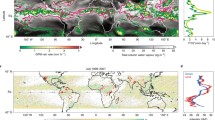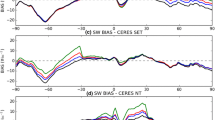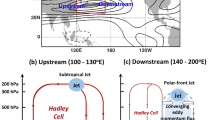Abstract
The balance conditions of relative angular momentum and time-mean kinetic energy and their annual variations are studied for the Northern Hemisphere tropical belt. The belt is divided into two roughly equal size parts, the monsoon and the extramonsoon regions. The data used consist of all available daily rawinsonde reports from the world areological network for the two 5-year periods 1958–63 and 1968–73.
In winter, the trade winds in the monsoon and extramonsoon regions are both sources of westerly relative angular momentum for the middle latitude circulation. However, it is found that the angular momentum gained in the extramonsoon region of the Tropics is mostly destroyed by a net southward flow of mass in that region, and becomes regenerated in the monsoon region by a net northward flow of mass there. This excess of angular momentum together with the angular momentum picked up locally in the monsoon region is almost all exported across its northern boundary. It is further found that in winter the Tropics are also an important source of mean kinetic energy for middle latitudes. Again almost all export of kinetic energy was found to take place across the northern boundary of the monsoon sector. Most of this energy must be generated through the pressure gradient term inside the monsoon region itself, the transformation from transient eddy kinetic energy being very small. The proper evaluation of the pressure gradient appears to be the main stumbling block in the present study, preventing us from estimating the generation and thereby, as a residual, the frictional dissipation in the two regions.
In summer, the extramonsoon region remains a source of angular momentum, but the monsoon region with its surface westerlies acts as a sink, leading to a sharp reduction (and even a midsummer reversal) of the export into middle latitudes. Also the export of mean kinetic energy almost vanishes in summer, except for a small southward transfer across the equator. The calculations for two 5-year periods give very similar estimates and thereby show the reliability of the results.
Similar content being viewed by others
References
Hellerman, S. (1967),An updated estimate of the wind stress on the world ocean, Monthly Weather Review95, 607–626, (see also corrections in Monthly Weather Review96, 63–74 (1968)).
Holopainen, E. O. (1964), Investigation of friction and diabatic processes in the atmosphere, Societas Scientiarum Fennica, Commentationes Physico-Mathematicae XXIX: 9, 47 pp.
Keshavamurty, R. N. (1968),On the maintenance of the mean zonal motion in the Indian summer monsoon, Monthly Weather Review96, 23–31.
Keshavamurty, R. N. (1971)On the maintenance of the mean Indian southwest monsoon circulation and the structure and energetics of monsoon disturbances, Ph.D. thesis, University of Mysore, India, 294 pp.
Kung, E. C. (1970).On the meridional distribution of source and sink terms of the kinetic energy balance, Monthly Weather Review98, 911–916.
Kung, E. C. (1971),A diagnosis of adiabatic production and destruction of kinetic energy by the meridional and zonal motions of the atmosphere, Quart. J. Roy. Meteor. Soc.,97, 61–74.
Kung, E. C. (1975),Balance of kinetic energy in the tropical circulation over the Western Pacific, Quart. J. R. Met. Soc.101, 293–312.
Newell, R. E., Kidson, J. W., Vincent, D. G. andBoer, G. J.,The General Circulation of the Tropical Atmosphere and Interactions with Extratropical Latitudes, Vol. 1, (M.I.T. Press, Cambridge, Mass, 1972), 258 pp. (see Chapter 4), pp. 131–164).
Newton, C. W. (1971a),Mountain torques in the global angular momentum balance, J. Atmos. Sci.28, 623–628.
Newton, C. W. (1971b)Global angular momentum blance: earth torques and atmospheric fluxes, J. Atmos. Sci.28, 1329–1341.
Oort, A. H. andBowman, H. D., II (1974),A study of the mountain torque and its interannual variations in the Northern Hemisphere, J. Atmos. Sci.31, 1974–1982.
Oort, A. H. andPeixóto, J. P. (1974),The annual cycle of energetics of the atmosphere on a planetary scale, J. Geophys. Res.79, 2705–2719.
Sadler, J. C. (1975),The upper tropospheric circulation over the global Tropics, UHMET 75-05, University of Hawaii, Honolulu, Hawaii.
Schulman, L. L. (1973),On the summer hemisphere Hadley cell, Quart, J. R. Met. Soc.,99, 197–201.
Author information
Authors and Affiliations
Rights and permissions
About this article
Cite this article
Oort, A.H., Chan, P.H. On the role of the Asian monsoon in the angular momentum and kinetic energy balances of the tropics. PAGEOPH 115, 1167–1186 (1977). https://doi.org/10.1007/BF00874405
Received:
Issue Date:
DOI: https://doi.org/10.1007/BF00874405




